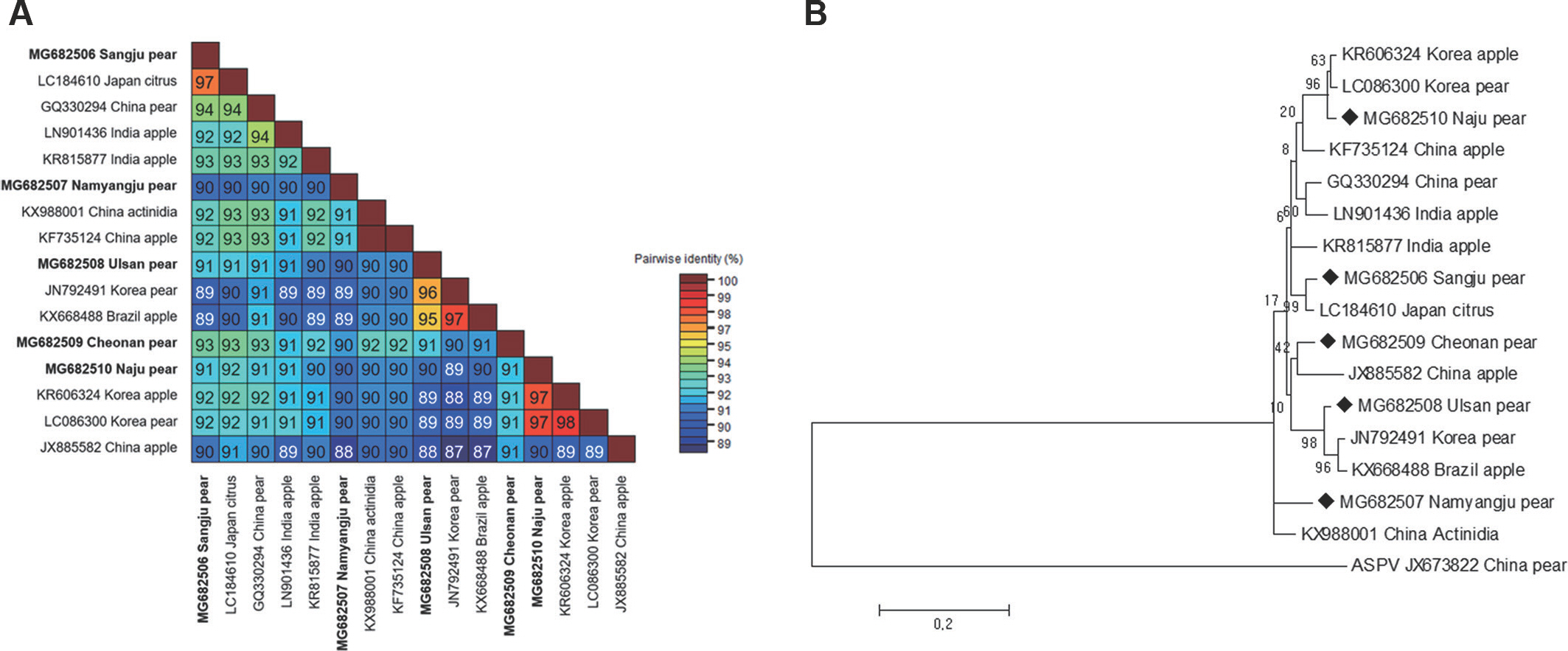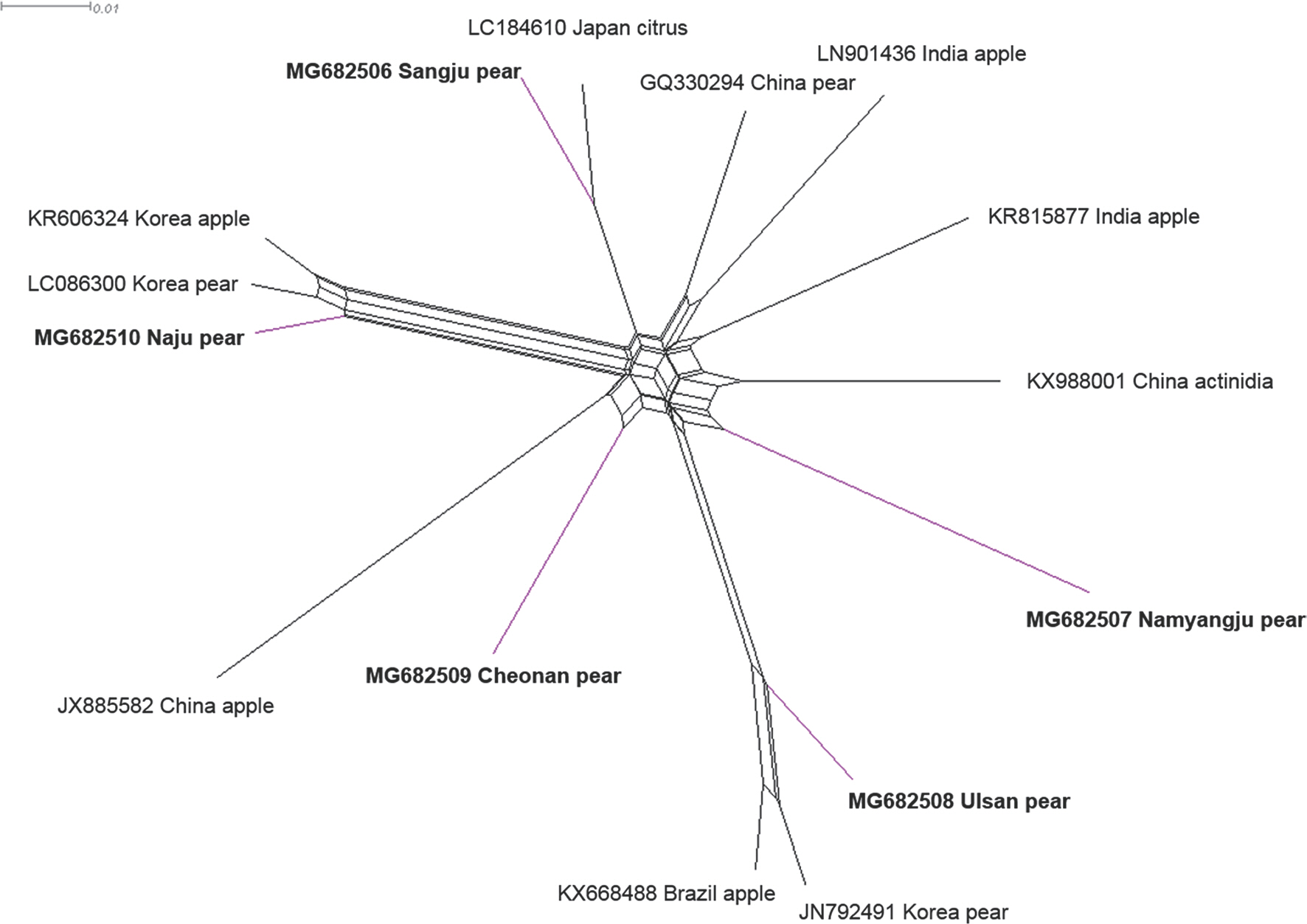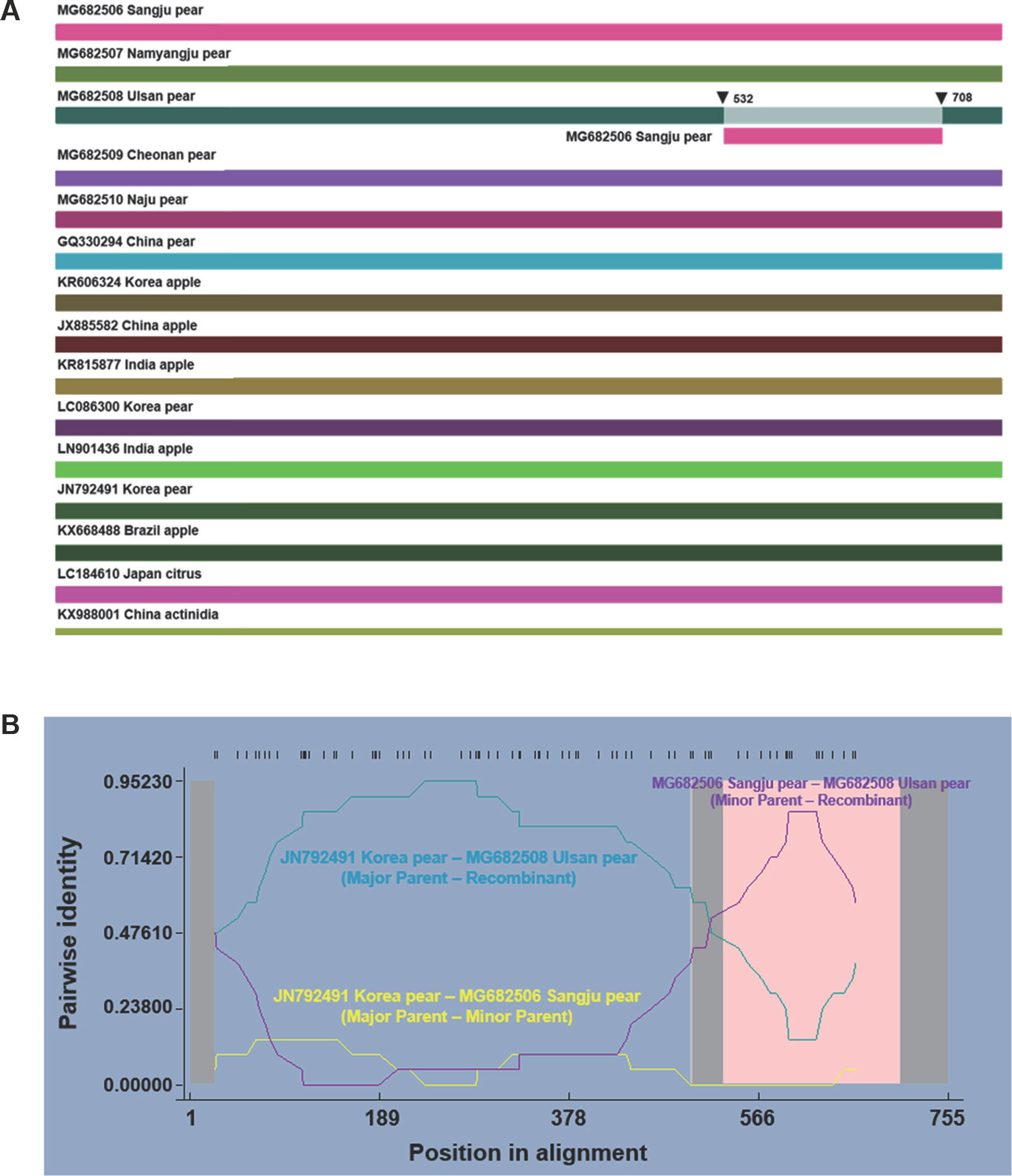Adams, M. J., Candresse, T., Hammond, J., Kreuze, J. F., Martelli, G. P., Namba, S. et al. 2012. Family Betaflexiviridae. In: Virus Taxonomy: Classification and Nomenclature of Viruses. Ninth Report of the International Committee on the Taxonomy of Viruses, eds. by A. M. Q. King, M. J. Adams, E. B. Carstens and E. J. Lefkowitz, pp. 920-941. Elsevier-Academic Press, Amsterdam, The Nether-lands.
Alabi, O. J., Rwahnih, M. A., Mekuria, T. A. and Naidu, R. A. 2014. Genetic diversity of Grapevine virus A in Washington and Califor-nia vineyards.
Phytopathology 104: 548-560.


Bao, Y., Chetvernin, V. and Tatusova, T. 2012. Pairwise sequence comparison (PASC) and its application in the classification of filoviruses.
Viruses 4: 1318-1327.



Chare, E. R. and Holmes, E. C. 2006. A phylogenetic survey of recombination frequency in plant RNA viruses.
Arch. Virol. 151: 933-946.



Chen, H., Chen, S., Li, Y., Ye, T., Hao, L., Fan, Z. et al. 2014. Phylogenetic analysis and recombination events in full genome sequences of. Apple stem grooving virus. Acta Virol. 58: 309-316.
Cho, I. K., Kim, D. H., Kim, H. R., Chung, B. N., Cho, J. D. and Choi, G. S. 2010. Occurrence of pome fruit viruses on pear trees (
Pyrus pyrifolia) in Korea.
Res. Plant Dis. 16: 326-330.

Chung, B. N., Kwon, S. J., Yoon, J. Y. and Cho, I. S. 2022. First report of
Cnidium officinale as a natural host plant of apple stem grooving virus in South Korea.
Plant Dis. 106: 338.


Cordin, O., Hahn, D. and Beggs, J. D. 2012. Structure, function and regulation of spliceosomal RNA helicases.
Curr. Opin. Cell Biol. 24: 431-438.


Dhir, S., Zaidi, A. A. and Hallan, V. 2013. Molecular characterization and recombination analysis of the complete genome of. Apple chlorotic leaf spot virus. J. Phytopathol. 161: 704-712.
Garc├Ła-Arenal, F., Fraile, A. and Malpica, J. M. 2001. Annu. Rev. Phytopathol. 39: 157-186.
Gibbs, M. J., Armstrong, J. S. and Gibbs, A. J. 2000. Sister-scanning: a MonteCarlo procedure for assessing signals in recombinant sequences.
Bioinformatics 16: 573-582.



Holmes, E. C. 2009. The evolutionary genetics of emerging viruses.
Annu. Rev. Ecol. Evol. Syst. 40: 353-372.

Hong, K. H., Kim, Y. S., Kim, W. C., Kim, J. B., Lee, U. J., Lee, E. J. et al. 1985. Studies on the abnormal spot disease in pear leaf. Res. Rept. RDA (Hortic.) 27: 46-55.
Huson, D. 1998. SplitsTree: analyzing and visualizing evolutionary data.
Bioinformatics 14: 68-73.



Kim, J., Lal, A., Kil, E. J., Kwak, H. R., Yoon, H. S., Choi, H. S. et al. 2021. Adaptation and codon-usage preference of apple and pear-infecting apple stem grooving viruses.
Microorganisms 9: 1111.



Kim, N. Y., Oh, J., Lee, S. H., Kim, H., Moon, J. S. and Jeong, R. D. 2018. Rapid and specific detection of
Apple stem grooving virus by reverse transcription-recombinase polymerase amplification.
Plant Pathol. J. 34: 575-579.




Larkin, M. A., Blackshields, G., Brown, N. P., Chenna, R., McGettigan, P. A., McWiliam, H. et al. 2007. Clustal W and Clustal X version 2.0.
Bioinformatics 23: 2947-2948.



Lee, D. S., Lee, H. K., Kim, S. Y., Kwon, B. R., Yang, H. J., Park, C. Y. et al. 2023. Complete genome sequences of two apple stem grooving viruses in
Cnidium officinale in Korea.
Microbiol. Resour. An-nounc. 12: e00902-22.




Lefkowitz, E. J., Dempsey, D. M., Hendrickson, R. C., Orton, R. J., Sid-dell, S. G. and Smith, D. B. 2018. Virus taxonomy: the database of the International Committee on Taxonomy of Viruses (ICTV).
Nucleic Acids Res. 46: D708-D717.



Lian, S., Lee, J. S., Cho, W. K., Yu, J., Kim, M. K., Choi, H. S. et al. 2013. Phylogenetic and recombination analysis of Tomato spotted wilt virus.
PLoS ONE 8: e63380.



Li, Y., Xia, Z., Peng, J., Zhou, T. and Fan, Z. 2013. Evidence of recombination and genetic diversity in southern rice black-steaked dwarf virus.
Arch. Virol. 158: 2147-2151.



Liu, P., Zhang, L., Zhang, H., Jiao, H. and Wu, Y. 2013. Detection and molecular variability of
Apple stem grooving virus in Shaanxi, China.
J. Phytopathol. 161: 445-449.


Martin, D. P., Posada, D., Crandall, K. A. and Williamson, C. 2005a. A modified bootscan algorithm for automated identification of recombinant sequences and recombination breakpoints.
AIDS Res. Hum. Retroviruses 21: 98-102.


Martin, D. and Rybicki, E. 2000. RDP: detection of recombination amongst aligned sequences.
Bioinformatics 16: 562-563.



Martin, D. P., Williamson, C. and Posada, D. 2005b. RDP2: recombination detection and analysis from sequence alignments.
Bioinformatics 21: 260-262.



Nam, K. W. and Kim, C. H. 1994. Studies on the pear abnormal leaf spot disease. 1. Occurrence and damage. Korean J. Plant Pathol. 10: 169-174.
Negi, A., Rana, T., Kumar, Y., Ram, R., Hallan, V. and Zaidi, A. A. 2010. Analysis of the coat protein gene of Indian strain of. Apple stem grooving virus. J. Plant Biochem. Biotechnol. 19: 91-94.
Ohira, K., Ito, T., Kawai, A., Namba, S., Kusumi, T. and Tsuchizaki, T. 1994. Nucleotide sequence of the 3'-terminal region of
Citrus tatter leaf virus RNA.
Virus Genes 8: 169-172.



Padidam, M., Sawyer, S. and Fauquet, C. M. 1999. Possible emergence of new geminiviruses by frequent recombination.
Virol-ogy 265: 218-255.

Posada, D. and Crandall, K. A. 2001. Evaluation of methods for detection recombination from DNA sequences: computer simulation.
Proc. Natl. Acad. Sci. U. S. A. 98: 13757-13762.


Shim, H., Min, Y., Hong, S., Kwon, M., Kim, D., Kim, H. et al. 2004. Nucleotide sequences of a Korean isolate of
Apple stem grooving virus associated with black necrotic leaf spot disease on pear (
Pyrus pyrifolia).
Mol. Cells 18: 192-199.


Smith, J. M. 1992. Analyzing the mosaic structure of genes.
J. Mol. Evol. 34: 126-129.



Takahashi, T., Saito, N., Goto, M., Kawai, A., Namba, S. and Yamshita, S. 1990. Apple stem grooving virus isolated from Japanese apricot (Prunus mume) imported from China. Res. Bull. Plant Prot. Serv. Jpn. 26: 15-21.
Tamura, K., Peterson, D., Peterson, N., Stecher, G., Nei, M. and Kumar, S. 2011. MEGA5: molecular evolutionary genetics analysis using maximum likelihood, evolutionary distance, and maximum parsimony methods.
Mol. Biol. Evol. 28: 2731-2739.



Welsh, M. F. and van der Meer, F. A. 1989. Apple stem grooving. In: Virus and Viruslike Diseases of Pome Fruits and Simulating Nonin-fectious Disorders, ed. by P. R. Fridlund, pp. 127-137. Cooperative Extension College of Agriculture and Home Economics, Washington State University, Pullman, WA, USA.
Yoon, J. Y., Joa, J. H., Choi, K. S., Do, K. S., Kim, H. C. and Chung, B. N. 2014. Genetic diversity of a natural population of
Apple stem pitting virus isolated from apple in Korea.
Plant Pathol. J. 30: 195-199.










 PDF Links
PDF Links PubReader
PubReader ePub Link
ePub Link Full text via DOI
Full text via DOI Download Citation
Download Citation Supplement
Supplement Print
Print






